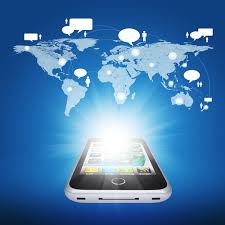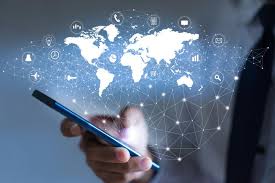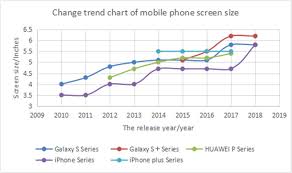Smartphone technology refers to a mobile telephone with a screen, built-in programs such as a calendar found in a PDA, as well as an operating system that enables other computer software to be installed for web browsing, music, email, video, plus other applications. The technology can also be viewed as a portable computer incorporated within a mobile telephone. The first prototype was produced in 1993 by IBM and taken to the market by BellSouth. It consisted of a touchscreen interface that enabled a user to access a calendar, calculator, and address book, among others.

As computer memory and integrated circuits became more affordable over the following ten years, a smartphone became more like a computer, and more enhanced services like the Internet became possible. In 2001, the introduction of the third-generation mobile phone networks resulted in the services becoming ubiquitous (Islam et al., 2017, p.230). Before this, the majority of the phones could send as well as receive data at speeds sufficient for text messages and telephone calls (Rossetto, 2018). Using the third-generation technology, data could be sent and received at higher speeds or rates. For instance, after its introduction, individuals would now send and receive video clips, photographs, emails, and music files.

A smartphone contains either a standard QWERTY keyboard or one with a telephone number pad for emailing, messaging, or web browsing. A virtual keyboard can be incorporated into a touch screen design. The technology allows a built-in camera that can record and transmit both photographs and videos. Additionally, many of these devices can access Wi-Fi so that a user access voice over Internet protocol instead of paying cell phone transmission charges. The increased capabilities of portable devices, as well as transmission protocols, have facilitated an increase in innovative and unbelievable applications. One of the applications includes augmented reality, whereby the device’s GPS location chip is used to overlay the street scene’s camera view with data like the identity of stores, real estate listings, or points of interest.
Evolution of the Smart Phone Technology
The transformation of this technology has evidence that equipment once intended for communication use only has become a necessity in various sectors such as an online purchase. The Blackberry and iPhone of the 2000s and the various applications that soon followed altered how people communicate, entertain themselves, interact in business or socially, as well as learn. Technology has always been a driver of the growing global economy, but it is just recently that smartphone technology became a significant economic factor. The major reason for this is that many of the phones are manufactured by some developed countries. In 2013, the mobile economy contributed more than two trillion dollars to the global economy, accounting for almost four percent of international gross domestic product. Apart from just that, more than ten million individuals got employment, and more than three hundred billion dollars was contributed to the US public funding.
The obvious indicator that smartphone technology is a critical component in the economy is that many individuals now own one. Based on a report by Pew Research Centre, about sixty percent of grownups in the US have a smart mobile device, whereas a cell phone is owned by ninety percent of them (Paudel, 2018, p.800). As the device becomes more inexpensive and more functional, the percentage of people owning one will increase. Internationally, the penetration of the device has nearly doubled in the last five years. In 2010, it was approximated that around twenty percent of the world population utilized the technology. In 2014, the percentage increased to thirty-seven, which is a seventeen-percent increase. Looking at the year that Apple iPhone became available; the percentage stood at twelve percent, which shows that from 2008 to 2014, the percentage has more than doubled.
One of the ways that prove smartphone technology has impacted the global economy is the dramatic increase in the capacity to communicate and collaborate. Indeed, the capacity to contact other people from any part of the world has significantly contributed to economic development. Nonetheless, it has also aided organizations to save finances used on activities that are not necessary anymore. For instance, mobile-compatible conferencing software like Citrix’s GoToMeeting enables the users to share data and voice from work locations. As a result, delays, as well as the need for executives to travel physically from one location to another worldwide, are reduced.
The creation of the app economy has also been a factor in the growth of the budget. As early as 2012, it was approximated that five hundred thousand jobs were created due to the app economy. It is noteworthy to remember that the approximate figure fails to include the manufacture, design, or marketing of the devices (Paudel, 2018, p.800). Another advantage is the dramatic reduced hindrance to entry that the new industry offers. Rather than requiring a huge manufacturing workforce or capacity, entrepreneurs take an idea, learn how to code or employ someone, and use the platforms created by companies Google or Apple to distribute their solution to an international market.
Among the main advances that smartphone technology has facilitated is the rise in the number of applications that use excess capacity. This stands for assets, capital or otherwise, that are underutilized (Wirjawan et al., 2020, p.25). The best example of such is the Uber app, which assists individuals in moving from one place to another like a taxi. It allows an individual with a vehicle, one that is new or properly kept, to utilize it to earn money by offering other individuals ride (Straub, 2015, p.315). The application manages riders who are the customers and the drivers effectively, which reduces the costs incurred when trying to get a ride. The car owner is able to utilize their car that would have remained idle.
The impact of smartphone technology has even been felt by the developing world. An incredible effect of its capacity to bridge the infrastructure and technology gap that is in the developing countries (Nolen et al., 2018, p.11). The increased access to the technology and the continuous affordable smartphones allow great promise as well as economic opportunities for organizations worldwide (Han et al., 2019, p.27). While moonshot projects can be far-fetched, they provide a peep at a long-haul development in developing countries, including more global access to the economy (Mendes et al., 2020, p.855). As the devices’ functionality and ease of operating continue to increase, the devices remain the economy’s integral economic part.

New Changes Brought by the Smartphone Technology
The adoption of smartphone technology has altered many things, which also demands the Internet. However, there is another way of viewing the Internet, for instance, from the back and the front. Like the personal computer revolution of the 90s, the last ten years demanded innovation in data compression, API connectivity, protocols, and user interface. Apart from the Internet, the technology has shifted how developers think concerning coding (Hilty et al., 2019, p.520). The desire to push dynamic, small, and reactive updates to mobile browsers has allowed the creation of the micro-service API. This has cascaded to the kind of data stored by different users (Siebel, 2019). The millions of bite-sized records are utilized instead of huge data structures, leading individuals to edge computing. The user behavior has also changed over the years, as suggested by (Grossi, 2019, p.580). Smartphone technology defines and extends how individuals communicate, as suggested by Grossi (2019, p.580). It has also reduced the need for physical memory (Grossi, 2019, p.580). Smartphones help people navigate and share their experiences with others.
Future of the Smartphone Technology
Predicting the future of technology is trying to forecast impending traits or qualities of useful technological techniques, machines, or procedures. Scholars create technology predictions according to previous experiences and present technological advancements (Kerst et al., 2020, p.145). The story about smartphone technology started with technological breakthroughs and ingenuity but ultimately morphed into an annual cadence of continuous improvements (Yasaka, Lehrich and Sahyouni, 2020). Within the next decade, when individuals take a look at the devices, it is expected that they are going to narrate one of the two stories once again. The most probable story to narrate in the future still remains to be the constant improvements. The version of the devices used today will be more advanced (Choi et al., 2018, p.1785). Even with the continuous enhancements, the smartphone will be better than how it is today and different too (Sutisna et al., 2020, p.223). The screen brightness will be more and might fold in various ways. The camera will be more enhanced to make people question the use of even high-end SLRs.
It is easy to undervalue the importance of constant enhancements of smartphone technology. For instance, due to the continued improvement of the camera, applications such as Instagram exist (De La Cruz Monroy and Mosahebi, 2019, p.250). The OLED is another way of displaying pixels, but it is flexible and consumes less power. Thus, a phone can fold in half, and the user takes a call on their wrist computer (Girl, Gupta, and Agarwal, 2020, p.7). A simple and incremental enhancement in a component can make the phone work faster or surprise people by acting as a catalyst in the shift in culture (Christensen, 2013). It is the chip that is enclosed in the top-end phones that enables them to locate other devices in space plus also transmit small amounts of data, for example, to unlock a door.
Currently, it is utilized to locate gadgets in the couch cushions, and there is a promise it will unlock a car door soon. However, in the same manner, people did not realize that GPS and data would result in the Uber app, which is still unknown what possibilities UWB could bring (Davalbhakta et al., 2020, p.12). Regardless of what happens in the future, the constant improvements path for smartphone technology will mean that all phones launch will have less excitement than the prior one. This also does not mean that they will be less impactful or important. Rather, they will become more familiar and an integral part of the society.
Impact of Intellectual Property on the Advancement of Smartphone Technology
Smartphone patents help with the protection of intellectual property as well as innovations used in developing mobile devices. About one billion individuals worldwide own portable devices to access the Internet and utilize software through Android or iPhone OS platforms. Xiaomi, which is among the growing smartphone developers, predicted that it would sell one hundred million devices six years ago. As technology is almost everywhere, the majority of the patents have been granted to protect the technologies utilized to develop the devices. In 2012, one-sixth of active patents were smartphone technology-related which is more than two hundred and fifty thousand patents, a figure bound to increase (Comino, Manenti and Thumm, 2019, p.410). Assuming that every patent has been confronted about twenty times, it shows that more than five million innovations have been prevented. According to (Andersson, Hiselius and Adell, 2018, p.54), approximately two million lawyers would be needed to handle the cases. Many organizations, especially the top ones in the world, own major smartphone portfolios.
For instance, in 2013 alone, Samsung filed more than two thousand applications associated with smartphones which is thrice the number of applications filed by Apple. Whereas this level of patent activity is a great sign of innovation in the field, many people as well as organizations who doubt the patents’ value are worried. Some people argue that patents result in high costs of acquiring smartphone technologies, whereas others are afraid of the significance of enforcement which includes lawful threats sent to businesses alleged of patent violation.
There is another section that views the extent of smartphone-related patents as well as challenges as a sign of the problems with the patent system. For instance, Microsoft has sued Kyocera while claiming that the latter’s smartphone violates their numerous patents. This lawsuit cost Kyocera a lot of money, estimated to be in the range of hundreds of millions. However, this fails to support the concept that patents have ruined innovation in the sector. The smartphone has morphed quicker than any other consumer product over the last ten years. There is evidence of more devices put out in the market and new innovations such as waterproof technology.
Many organizations have brought smartphone technology into cars and other vehicles. The Android Auto systems and Apple CarPlay enable drivers to easily incorporate their phones with vehicle infotainment systems. Such innovations can be accredited to Apple’s patent portfolio, including a patent for this kind of device. If the company did not have a patent portfolio, it would be illegal for them to promote or sell the technology. Several companies in 2011 made a bid to challenge a giant in the tech world by buying more than six thousand patents. It is reported that the late Steve Jobs viewed Android as a stolen idea and was determined to destroy it. Nevertheless, many individuals in the industry anticipate multimillion-dollar lawsuits filed by Apple, Microsoft, and Google to taper off in the near future.
Reference List
Andersson, A., Hiselius, L.W. and Adell, E. 2018. Promoting sustainable travel behaviour through the use of smartphone applications: a review and development of a conceptual model. Travel behaviour and society, 11, pp. 52-61.
Choi, Y.K., Demiris, G., Lin, S.Y., Iribarren, S.J., Landis, C.A., Thompson, H.J., McCurry, S.M., Heitkemper, M.M. and Ward, T.M. 2018. Smartphone applications to support sleep self-management: review and evaluation. Journal of Clinical Sleep Medicine, 14(10), pp.1783-1790.
Christensen, C. 1997. How can great firms fail. Insights from the hard disk drive industry. In.
Christensen, C.M. 2013. The innovator’s dilemma: when new technologies cause great firms to fail. Harvard Business Review Press.
Comino, S., Manenti, F.M. & Thumm, N. 2019. The role of patents in information and communication technologies: A survey of the literature. Journal of Economic Surveys, 33(2), pp. 404-430.
Davalbhakta, S., Advani, S., Kumar, S., Agarwal, V., Bhoyar, S., Fedirko, E., Misra, D.P., Goel, A., Gupta, L. and Agarwal, V. 2020. A systematic review of smartphone applications available for corona virus disease 2019 (COVID19) and the assessment of their quality using the mobile application rating scale (MARS). Journal of medical systems, 44(9), pp. 1-15.
De La Cruz Monroy, M.F. & Mosahebi, A. 2019. The use of smartphone applications (apps) for enhancing communication with surgical patients: a systematic review of the literature. Surgical innovation, 26(2), pp. 244-259.
Grossi, M. 2019. A sensor-centric survey on the development of smartphone measurement and sensing systems. Measurement, 135, pp. 572-592.
Han, X., Scheetz, J., Keel, S., Liao, C., Liu, C., Jiang, Y., Müller, A., Meng, W. and He, M. 2019. Development and validation of a smartphone-based visual acuity test (vision at home). Translational vision science & technology, 8(4), pp. 27-27.
Hilty, D.M., Chan, S., Torous, J., Luo, J. and Boland, R.J. 2019. Mobile health, smartphone/device, and apps for psychiatry and medicine: competencies, training, and faculty development issues. Psychiatric Clinics, 42(3), pp. 513-534.
Huang, X., Xu, D., Chen, J., Liu, J., Li, Y., Song, J., Ma, X. and Guo, J. 2018. Smartphone-based analytical biosensors. Analyst, 143(22), pp. 5339-5351.
Islam, M.M., Hasan, M.K., Billah, M.M. and Uddin, M.M. 2017. Development of smartphone-based student attendance system. In 2017 IEEE Region 10 Humanitarian Technology Conference (R10-HTC) (pp. 230-233). IEEE.
Kerst, A., Zielasek, J. & Gaebel, W. 2020. Smartphone applications for depression: a systematic literature review and a survey of health care professionals’ attitudes towards their use in clinical practice. European archives of psychiatry and clinical neuroscience, 270(2), pp. 139-152.
Liu, R., Lai, K.K., Lin, C.Y., Su, F.P. and Shih, H.C. 2018. Litigation Patents Knowledge Flow of Smartphone: Based on the Technology Field Citation Network. In Proceedings of the 4th International Conference on Industrial and Business Engineering (pp. 197-202).
Mendes, J., Pinho, T.M., Neves dos Santos, F., Sousa, J.J., Peres, E., Boaventura-Cunha, J., Cunha, M. and Morais, R. 2020. Smartphone applications targeting precision agriculture practices—a systematic review. Agronomy, 10(6), p. 855.
Nolen, S.L., Giblin-Scanlon, L.J., Boyd, L.D. and Rainchuso, L. 2018. Development and testing of a smartphone application prototype for oral health promotion. American Dental Hygienists’ Association, 92(2), pp. 6-14.
Paudel, N. 2018. Smartphone applications for amblyopia treatment: a review of current apps and professional involvement. Telemedicine and e-Health, 24(10), pp. 797-802.
Rossetto, E. 2018. Patent War in the Smartphone Industry: Focus on the Role of Patent Trolls Companies (Bachelor’s thesis, Università Ca’Foscari Venezia).
Siebel, T.M. 2019. Digital transformation: survive and thrive in an era of mass extinction. RosettaBooks.
Straub, J. 2015. In search of technology readiness level (TRL) 10. Aerospace Science and Technology, 46, pp. 312-320.
Sutisna, D., Widodo, A., Nursaptini, N., Umar, U., Sobri, M. and Indraswati, D. 2020. An analysis of the use of smartphone in students’ interaction at senior high school. In Proceedings of the 1st Annual Conference on Education and Social Sciences (ACCESS 2019) (Vol. 465, pp. 221-224).
Wirjawan, J.V., Pratama, D., Pratidhina, E., Wijaya, A. and Untung, B. 2020. Development of Smartphone App as Media to Learn Impulse-Momentum Topics for High School Students. International Journal of Instruction, 13(3), pp. 17-30.
Yasaka, T.M., Lehrich, B.M. & Sahyouni, R. 2020. Peer-to-peer contact tracing: development of a privacy-preserving smartphone app. JMIR mHealth and uHealth, 8(4), p.e18936.
Zhang, M., Li, H. & Liu, X. 2020. Technology Trend Study Based on Valid Patents of Smartphone Industry. J. Econ. Bus. Manag., 8(2).